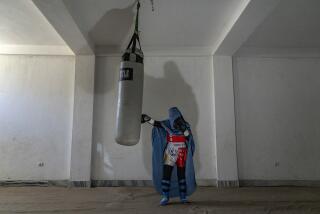Bazaars in Afghanistan Thrive Despite Occupation
- Share via
KABUL, Afghanistan — Despite the Soviet Union’s widespread influence here, seven years after the Soviet military occupation began, there is no sign of a controlled economy in Kabul’s bustling bazaars.
A free market flourishes, as it has for centuries in this caravan crossroads, and consumers have their choice of some of the best goods that the West has to offer. Japanese stereos, Swiss watches, Finnish toilet paper, German and Dutch beer, Scotch whisky and American blue jeans can be purchased by anyone with enough afghani, the local currency.
This is in sharp contrast to the situation in Moscow, where such merchandise is either unavailable or constantly in short supply.
Has Money Exchange
So sophisticated is the bazaar that some merchants will gladly accept foreign currencies.
Kabul even has a money bazaar, where foreign money is bought and sold without regard to the official rates fixed by the Bank of Afghanistan. At the bazaar, the U.S. dollar ranks far above the Soviet ruble in terms of desirability.
Officially, the rate is 56 afghani for one U.S. dollar. At the bazaar, though, it is possible to get as many as 143 afghani for a dollar. The ruble, valued at $1.40 in Moscow, brings only 25 afghanis at the bazaar. The dual currency system was described as “half-legal” by Amandoddin Salyed Amin, deputy chairman of Afghanistan’s Council of Ministers. He is in charge of the government’s relations with business.
“Somehow, it’s accepted by the government,” Amin said in an interview with foreign journalists. “If private parties want to import a TV set from Japan (rather than buy through the bazaar), they acquire foreign currency where they can.”
The abundance of imported luxury goods seems incongruous in Afghanistan, one of the world’s poorest countries, which has been fighting a guerrilla war since 1978. The Soviet Union has sent in about 120,000 troops to deal with the rebels, who are being backed heavily by U.S. cash and weapons.
But the war, mostly far from Kabul’s city limits in recent months, does not seem to interfere with the lively commerce that begins soon after dawn every day in hundreds, if not thousands, of small shops.
Diplomats based in Kabul said the goods on sale in the shops are only a small fraction of the amount brought into the country, with many of the goods imported from Japan, West Germany, Switzerland, etc., being promptly smuggled out of Afghanistan to neighboring Pakistan or Iran.
There is no way to estimate the total value of consumer goods imported into this war-torn country. But an Asian diplomat said Afghanistan buys about $200 million worth of luxury goods from Japan every year, including electronic equipment and fancy textiles.
Although the profusion of individual entrepreneurs here is hardly consistent with the Soviet model, trying to change Afghans’ deeply ingrained trading habits undoubtedly would cause great resentment and probably would not work. So the Soviet officials look the other way--except when they go to the bazaars themselves to buy electronic goods, watches, clothes and other items that cannot be found in the Soviet Union.
Soviets Also Use Bazaar
There is no question that Soviet nationals who come to work or live in Afghanistan take advantage of the bazaar. On a recent flight from Kabul to Moscow, most of the Soviet passengers had three or four large cartons of Afghan purchases in their baggage.
Agriculture is the backbone of Afghanistan’s economy, and about 95% of the production remains in private hands, according to Amin, despite Soviet encouragement of collectivization. “In Afghanistan, for the time being, it’s not socialism,” he said. “This was a national, democratic revolution.”
(Afghanistan’s king was overthrown in 1973 in a military coup. In 1978, leftists ousted the regime and proclaimed the Democratic Republic of Afghanistan, triggering the start of the guerrilla rebellion. After months of factional upheaval within the ruling party, Soviet troops moved into Afghanistan on Christmas Day, 1979. They apparently have been able to stabilize the government but have not been able to defeat the rebels, mainly Muslim tribesmen.)
Government officials said the average wage for an urban worker in Afghanistan is 5,000 afghani a month--about $35 at the unofficial market exchange rate.
The prices of some basic commodities are kept low through government subsidies. For example, naan, the flat Afghan bread that, along with tea, is a dietary staple, costs only 6 afghani.
Since the fighting began eight years ago, inflation has been severe, 20% or 25% a year.
Military Service Takes Toll
Military service has taken a toll on the labor force and productivity. Somewhere between 50,000 to 100,000 young men are serving in the army, related militia groups and the large police forces.
In addition, millions of Afghans have fled to Pakistan and Iran, and this has had a devastating impact on the economy. The economy has also been affected by the shift of millions of people from rural areas to the cities for safety.
Even so, well-to-do Afghans in Kabul find it possible to rent hotel banquet rooms almost every evening for engagement and wedding parties. They invite 200 or more guests--at 300 afghani apiece--to sip soft drinks, dine on mutton and rice and listen to bands playing modern and traditional music.
“Since the revolution, life has been very bad for our people,” one Afghan told a reporter. “The first phase--so much killing--and since then, the war. Very bad days.”
More to Read
Sign up for Essential California
The most important California stories and recommendations in your inbox every morning.
You may occasionally receive promotional content from the Los Angeles Times.












